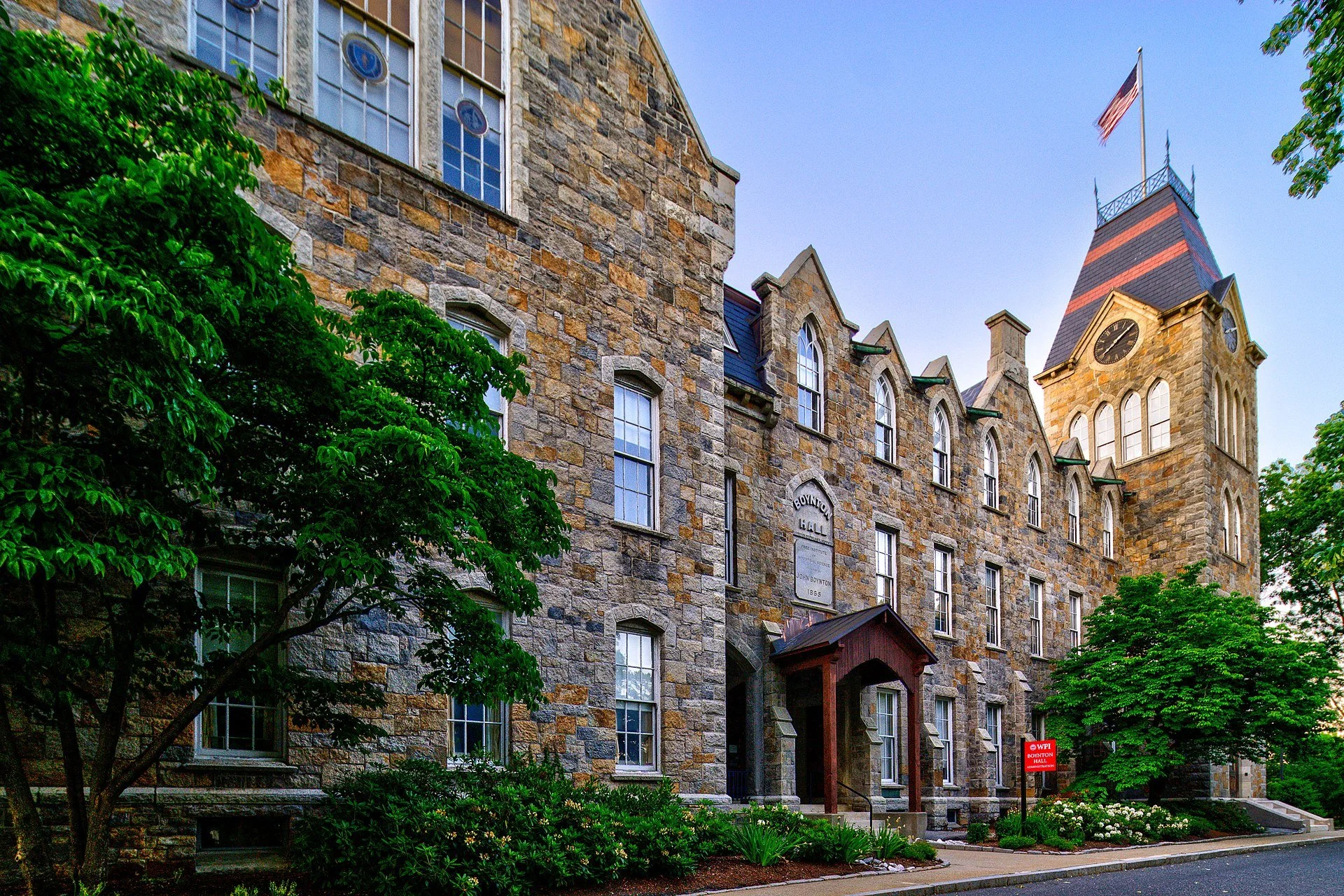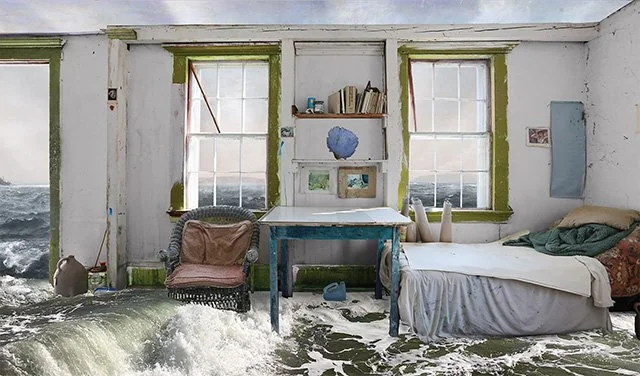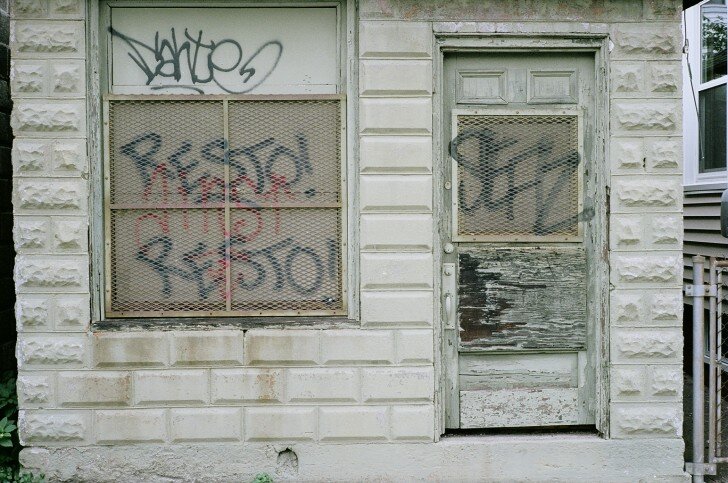“New Galaxies,’’ from the self-portrait series Dreaming Gave Us Wings,’’ 2017—present, by Sophia Nahli Allison, at the Museum of Art, Rhode Island School of Design, Providence.
Their little aerial game
Dropping sticks is a game
the summer crows have learned to
play, flying from May
to September, one above the other.
The higher lets his toy fall through the
air to the other of the pair,
who returns the favor. We gulp
to see these evening acrobats climb so
high, printed black against the sky
above the blacker hills.
They become absorbed in their little
game. It seems so tame:
one drops a stick, the other catches it,
what more is there to
say? Just that every day
my heart drops with it
through the empty air, till a strange
and gay and capricious bird, unknown to
me, catches that heart, and it soars again.
“Dropping Sticks,’’ by Frank Robinson, an Ithaca, N.Y.-based poet, art historian and a former director of the Johnson Museum of Art at Cornell University and the Museum of Art at the Rhode Island School of Design
“American Crow,’’ by John Jacob Audubon
William Morgan: For creative responses to the graffiti challenge
After a seemingly endless rampage of city-blighting graffiti, the mayor recently announced that the police had finally identified and charged the most notorious tagger who "soiled hundreds of walls and buildings." The alleged culprit could get two years in prison for defacing property, "which had to be cleaned using public funds."
Dumpster on Providence’s Smith Hill.
— All photos by William Morgan.
This was welcome news, as most citizens regard as vandalism the bubble signatures and symbols painted on blank walls, mailboxes, dumpsters, and electrical boxes. Some lawmakers, however, protested that graffiti was a minor issue, while one accused the mayor of cracking down on graffiti as "a way to forge political consensus."
The mayor, however, is not Jorge Elorza of Providence, but the mayor of Rome, Virginia Raggi, and the alleged tagger was identified as “Geco” (no full name given).
But whether it's Providence or the Eternal City, the problem of such urban defacement is old as human settlement. The ancient Romans battled it, as did the Egyptians centuries before that. During World War II, American G.I.s' painted “Kilroy Was Here’’ on walls from Anzio to Guadalcanal. Like the poor, graffiti will always be with us.
On Ives Street, in Providence’s Fox Point neighborhood.
Called tagging, painting your name in bold letters on the side of a building or a railroad car is about self-expression. Free spirits, the rebellious, and the disenfranchised tag their names to declare that they exist. According to Paolo von Vacaro, an authority on graffiti, "You tag your name to show that you are king of the street."
Competing artists lay their claims to a Providence wall.
As with many forms of self-expression, one man's creative genius is another's vandalism. One might admire the styles of particular graffitists, or how practitioners have artistic duels on public walls. But when the walls are historical, such as Providence Marine Corps of Artillery Arsenal, on Benefit Street, in a section of the city known for its historic architectural beauty, then graffiti is, according to the City of Providence, "a public nuisance and destructive of the rights and values of property owners as well as the entire community."
Defacing the Arsenal, the David Macaulay mural on I-95, or the Providence River pedestrian bridge is unacceptable. If residents and business are really stung by tagging, then they should push the city to get really serious about apprehending the spray-can brigade, and mete out fines stiff enough to cover the restoration of damaged walls and objects.
But how much of a public nuisance is the run-of-the-mill graffiti that covers so many walls, particularly in less affluent neighborhoods? Does it threaten the commonweal? Does painting freight cars make them less efficient? Or are the giant bubble letters symbolic of deeper strains within the community?
Masterpiece of railroad freight car graffiti.
Visual pollution is as unfortunate as it is indefinable: a certain building may enhance or offend, one man's Christmas lights may seem tacky to his neighbors. Graffiti, like smut (the late Supreme Court Justice Potter Stewart declared that he could not define smut, but knew it when he saw it), may be impossible to eradicate.
One of many injury law billboards.
If we are to tackle a city's visual pollution, why not eradicate the billboards that are a blot on the cityscape? As soon as you pass border signs admonishing you to “Discover Beautiful Rhode Island,’’ there are billboards touting one personal-injury law firm after another. (A traveler crossing Rhode Island for the first time might wonder if we do nothing here but chase ambulances)
Rocky and Bullwinkle mural visible from the train, by a 21st-Century Leonardo.
Why not a creative solution for the Creative Capital? If graffiti is a fact of city life, why not embrace it? The destruction of property should be discouraged by strict law enforcement, but the vibrancy of famous artist-provocateurs such as Banksy and Jean-Michel Basquiat should be encouraged. Why not embrace it?
How about hosting a graffiti conference and contest, where local talent and free-spirited geniuses from all over America would come to compete for a national title? Blank walls on warehouses, factories, and other structures would be donated. Providence businesses could sponsor walls, the Rhode Island School of Design could offer a residency for certain artists, and there could be conferences on tagging, along with publications, and maybe even art-school scholarships for disadvantaged would-be artists. Such an event could boost the city on many levels.
Many free-spirited paint bandits might balk at the contra-indication of control, so they would have to continue their vandalism as outlaws. But in the spirit of the successful Gravity Games of 1999-2001, let’s plan for some post-COVID-events that encourage fun, artistic energy, and above all, optimism.
“If your graffiti is exceptional, thank your art teacher’’ says my wife, Carolyn Morgan. Graffiti mural on North Main Street by Jasper Summers..
William Morgan is a Providence-based architectural historian, essayist and photographer. His latest book is Snowbound: Dwelling in Winter
Of factories, Florida and Alzheimer's
Many citizens wonder what to do with 19 acres of Providence land that have been made available for development by moving Route 195. What a huge opportunity!
The property is in the middle of New England’s second-largest city; alongside the East Coast’s “Main Street” — Route 95 — whose intersection with 195 created one of the East's big crossroads; next to internationally known academic institutions; spectacularly situated at the head of a great bay, and near a large hospital complex. And just down the road is Green Airport, which is being expanded to allow nonstop flights to the West Coast and Western Europe.
What to put on the property? Offices and academic facilities, especially those connected with medically related activities; design businesses (Rhode Island School of Design spinoffs?), restaurants, hotels and stores. But let’s not ignore manufacturing.
This would not be the “dark satanic mills” of yore, emitting thick pollutants into the air and water. Most American manufacturing is much, much cleaner these days. It also employs fewer people, as foreign factories and robotic systems here have taken over much of the work, though the factory workers we have are generally well paid. To make such high-end stuff as pharmaceuticals in plants on the 195 land is just common sense. Consider that the proximity of Routes 195 and 95 and Narragansett Bay’s ports makes shipping manufacturing materials into and finished products out of this part of Providence remarkably easy. And there’s lots of engineering expertise in the region.
And if you think that a factory can’t co-exist attractively with a thickly settled area, consider Genzyme’s plant in the Allston section of Boston.
But the area needs more and better mass transit to serve the neighborhood, whose warren of confusing streets could scare away car-based people. Eventually a couple of trolley lines (real ones, with rails) should run through the newly developed area to connect the old downtown, the medical complex to the south and College Hill. But let development be dense; sociological and other studies associate density with lower crime and higher urban energy. Planners for the land should keep out windswept parking lots.
All in all, the 195 land offers the biggest opportunity to raise the profile and thus the prosperity of Providence since the rivers were moved.
***
We just got back from Naples, Fla., where I worked and we saw relatives in one of the most demure parts of the peninsula. The overloaded airline system makes travel to and from the Sunshine State increasingly difficult. And the urbanization and suburbanization of much of Florida have tattered much of its semi-tropical beauty. Still, the warmth, the greenery and the ease of strolling compared with walking on New England’s icy streets, narrowed by inadequate snowplowing, made it seem paradisiacal. And the quiet was addictive; the sound of wind through the palms and the surf were the main background sounds as I typed in my brother-in-law’s office.
It brought back memories of a quiet, lush Florida from my childhood. I remember the smell of the orange groves, the roadside juice stands and the long stretches of unbuilt-on beach backed only with palmettos and dune grass. My first memory is of an old man throwing bread to pelicans on the beach in Siesta Key, near Sarasota. Later ones include discovering Key lime pie and stone crab, drinking from a coconut and enjoying the best roadside kitsch in America.
Parts of my family had been going to Florida for part of the winter since around World War I. Naturally they complained about its over-development. Of course, they helped start the problem. (However, they never took part in the sort of crazy land speculation immortalized in the Marx Brothers’ 1929 film “The Cocoanuts,” in which Groucho’s character keeps trying to unload swampland on unsuspecting investors. Not much has changed since then!)
When there’s something nice, we overuse it, which is what happened to Florida, especially after air-conditioning, interstate highways and jet travel made getting and staying there so much easier. The Florida that I briefly revisited the other week, just before its high season, evoked in me balmy nostalgia for a time before Florida became a mega-state.
***
Kudos to Cape Cod-based writer/editor/publisher Greg O’Brien, 64, who has been writing (as self-therapy) about Alzheimer’s disease since he was diagnosed with it, in 2009. One of his projects is his book “On Pluto: Inside the Mind of Alzheimer’s.” Then there’s my friend Berna Huebner, whose movie and book, “I Remember Better When I Paint,” describe how her mother, a successful Chicago-based painter, regained some of her skills and energy after she was persuaded to return to painting after Alzheimer’s seemed to doom her to a life of, by turns, agitation and depressed passivity. We’d better be looking for many routes for relief for dementia victims — and their families -- as the number of victims swells in the next two decades.
(In 2010, I wrote a magazine piece about this.)
Robert Whitcomb (rwhitcomb51@gmail.com), a former editor of The Providence Journal's Commentary pages, is a Providence-based writer and editor and the overseer of www.newenglanddiary.com. He is also a director of Cambridge Management Group (cmg625.com).

























